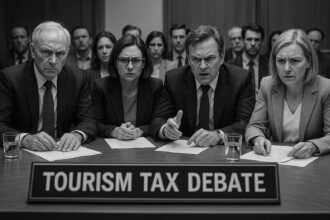Governor Andrew Bailey highlights how Trump’s unpredictable tariffs have increased volatility in UK interest rate forecasts, complicating business investment decisions and prompting calls for bolder monetary policy measures amid ongoing global market fluctuations.
Bank of England Governor Andrew Bailey has articulated the heightened uncertainty surrounding the UK’s interest rate trajectory, a situation he attributes largely to the unpredictable trade policies championed by former President Donald Trump. During a session with MPs from the Treasury select committee, Bailey expressed concern over how these policies complicate monetary policy, particularly the impact of fluctuating tariffs. “The path remains downwards, but how far and how quickly is now shrouded in a lot more uncertainty, frankly,” he noted. Over the past year, the Bank has lowered interest rates to 4.25% in four successive cuts, reflecting a deceleration in inflation.
Bailey highlighted that many businesses are currently hesitating to invest due to this ongoing uncertainty regarding trade agreements. He stated, “The impact of fragmenting the world trading system is negative for world growth and world activity,” underscoring the tangible effects on decision-making at the corporate level. Despite the recently established trade agreement between the UK and the US, he cautioned that tariffs remain elevated compared to conditions before Trump’s presidency, and with the UK’s economy being notably open, it remains particularly susceptible to global fluctuations.
Regarding wage growth, Bailey anticipates a decline in the coming months, which could influence the Monetary Policy Committee’s decisions on future rate cuts. He stated, “I have no evidence to doubt the steer from our agents’ pay survey that come the end of this year … wage settlements should be around 3.7-3.8%, which is a good percentage point below where we are now.” This projection could bolster confidence among policymakers in the context of potential further rate adjustments.
Financial markets have also demonstrated volatility linked to Trump’s fluctuating trade policies. Bailey noted, “Markets have moved quite a lot since our last meeting,” indicating the level of concern surrounding current economic realities. He pointed to a disturbing trend where equity markets are declining while US bond yields rise, suggesting that these shifts could compel changes in White House policy. He reflected on the historical context of market responses, stating, “We had two periods… where that became quite acute, frankly,” indicating that such market dynamics can prompt administrative action.
In this crucial dialogue on monetary policy, the contributions from external MPC members have also been noteworthy. Swati Dhingra, who has consistently advocated for lower interest rates, highlighted the potential long-term economic impacts of maintaining high rates, suggesting that a shift toward larger rate cuts may be necessary. “If we’ve held policy too tight for long, that starts to play a role,” she explained, emphasising the need for a reassessment of the existing monetary policy framework.
Catherine Mann, another external member, reinforced the call for bold policy shifts rather than incremental adjustments. “In order to make a clear statement about the stance of monetary policy appropriate for the UK, I think it’s important to make a bolder move, and then to hold for longer,” she stated, advocating for a more decisive approach to rate cuts.
As the Bank grapples with these challenges, it remains committed to a measured response in an increasingly unpredictable economic landscape. The intertwined dynamics of global trade, domestic economic indicators, and financial markets continue to shape the outlook for interest rates, leaving policymakers exercising caution as they navigate these murky conditions.
 Reference Map:
Reference Map:
- Paragraph 1 – [1], [3]
- Paragraph 2 – [1], [2], [4]
- Paragraph 3 – [5], [6]
- Paragraph 4 – [2], [4]
- Paragraph 5 – [1], [2]
- Paragraph 6 – [5], [6]
- Paragraph 7 – [1], [3]
Source: Noah Wire Services
- https://www.theguardian.com/business/2025/jun/03/uk-interest-rates-more-uncertain-due-to-trump-policies-says-bank-governor – Please view link – unable to able to access data
- https://www.reuters.com/world/uk/boes-bailey-sticks-with-gradual-careful-rate-cut-view-2025-06-03/ – Bank of England Governor Andrew Bailey has reaffirmed his ‘gradual and careful’ approach to interest rate cuts amid increasing global economic uncertainty, notably due to U.S. President Donald Trump’s trade actions. In May, the BoE reduced rates to 4.25%, reflecting policymakers’ growing concern over unpredictable market conditions. Bailey emphasized that while the trajectory for rates remains downward, the pace and extent of further cuts are now less clear. He noted that easing in the labour market, particularly slower pay growth, is vital for additional cuts. Deputy Governor Sarah Breeden supported the May rate cut and suggested trade turmoil wasn’t the sole justification. Bailey highlighted discrepancies between positive GDP figures and more pessimistic business surveys, attributing this to data inconsistencies complicating economic forecasting. The BoE anticipates modest annual growth of 1% in 2025, with a slight uptick to 1.5% by 2027.
- https://www.reuters.com/markets/europe/boes-bailey-sees-rate-path-shrouded-increasingly-by-uncertainty-2025-06-03/ – Bank of England Governor Andrew Bailey has expressed growing concern over the uncertainty surrounding the future path of interest rates. Speaking to the Treasury Committee, Bailey stated that while the general direction for interest rates remains downward, the pace and extent of these changes are now significantly less predictable. He attributed this increased uncertainty to global trade policy turmoil, which has added a new layer of unpredictability to economic forecasting. Bailey highlighted that the Bank has started using the term ‘unpredictable’ in addition to ‘uncertain’ to capture the complex and volatile nature of the current economic environment, underscoring the challenges policymakers face in determining future monetary policy decisions.
- https://www.reuters.com/world/uk/boes-bailey-says-uncertain-outlook-demands-careful-approach-rate-cuts-2025-05-29/ – Bank of England Governor Andrew Bailey emphasized a ‘gradual and careful’ approach to interest rate cuts due to continued global uncertainties impacting domestic inflation. Speaking at a finance industry event in Dublin, he justified the cautious stance following a recent rate cut to 4.25% from 4.5%, which he supported alongside a narrow majority on the Monetary Policy Committee. This decision comes amid surprises in inflation data, with consumer price inflation rising more than expected to 3.5% due to higher energy, water bills, and holiday airfare costs. Bailey noted uncertainty about whether this spike was seasonal and emphasized the slow easing of core inflation and persistent food price inflation, which heavily influence public perception. Labour market data appeared consistent with expectations. Additionally, Bailey advocated for stronger trade and financial ties with the European Union and a resolution to the U.S.-UK trade dispute. He also downplayed concerns that global economic fragmentation might threaten the U.S. dollar’s reserve currency status, suggesting limited rebalancing is likely but not a major shift.
- https://www.reuters.com/world/uk/boes-taylor-dismisses-inflation-concerns-renews-call-lower-rates-ft-reports-2025-05-30/ – Bank of England policymaker Alan Taylor dismissed recent inflation concerns despite the UK’s inflation rate rising to 3.5% in April from 2.6% in March. Attributing the spike to one-time tax and administered price changes, Taylor maintained his position advocating for lower interest rates to address economic risks, particularly those stemming from the U.S. trade war initiated by President Donald Trump. Alongside fellow Monetary Policy Committee member Swati Dhingra, Taylor previously voted for a larger half-point rate cut, although the committee ultimately reduced rates by only a quarter-point to 4.25% in May. Highlighting the potential for prolonged global trade disruptions to hinder domestic growth, Taylor emphasized the need for a more accommodative monetary policy. His stance follows a speech by BoE Governor Andrew Bailey, who supported a cautious approach to rate adjustments given the uncertain international trade landscape and its implications for inflation.
- https://www.ft.com/content/25d98ac2-f86c-41f5-92cc-a69024ba5234 – The article addresses the need for UK financial authorities, particularly the Bank of England (BoE), to proactively mitigate the risk of contagion from market disruptions caused by US President Donald Trump’s policies. Recent political interventions by Trump, including threats to dismiss Federal Reserve Chair Jay Powell and high tariff announcements, have rattled US Treasury markets. Given the historical correlation between rising US interest rates and increases in UK gilt yields, such developments could hurt UK investment, housing, and economic growth. The author urges the BoE to adopt pre-emptive communication strategies to prevent unwarranted rises in gilt yields by signaling a readiness to adjust monetary policy in reaction to US-induced financial stress. Doing so, they argue, could decouple UK gilts from US Treasury movements more effectively than past reactive measures. The article also suggests more flexibility in the BoE’s quantitative tightening program and proposes giving the BoE independence to set its own inflation targets, potentially reducing the inflation risk premium and insulating UK markets further. Emphasizing proactive policy signaling and independence could minimize adverse economic impacts from U.S. market volatility.
- https://www.bankofengland.co.uk/speech/2025/may/andrew-bailey-keynote-address-at-the-reykjavik-economic-conference-2025 – In his keynote address at the Reykjavik Economic Conference 2025, Bank of England Governor Andrew Bailey discussed the challenges of monetary policy in the face of unprecedented global shocks, including the largest pandemic in a century, the largest war in Europe since 1945, and a trade war between the world’s two largest economies. He highlighted the need for inflation targeting to adapt to manage trade-offs between the speed of returning inflation to target and balancing aggregate demand and supply. Bailey noted that the Bank of England’s remit, expanded in 2013, recognises circumstances where returning inflation to target quickly could cause undesirable volatility in economic activity and employment. He acknowledged that the current period is characterised by unprecedented global shocks, making monetary policy particularly challenging. Bailey emphasised the importance of multilateral forums in addressing global economic issues and cautioned against abandoning multilateralism, stating that the risks to the UK and global economy from trade wars are substantial.













